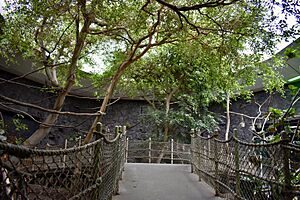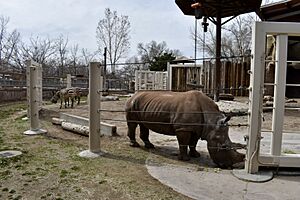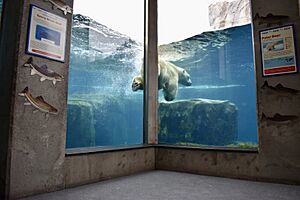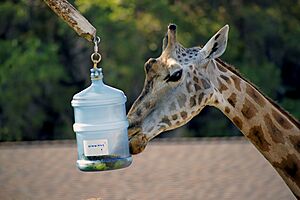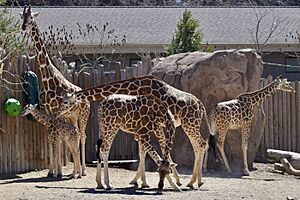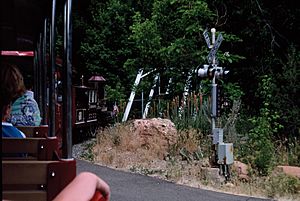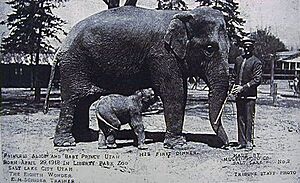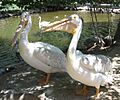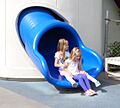Utah's Hogle Zoo facts for kids
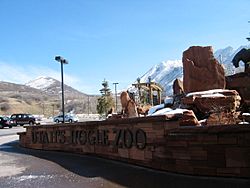 |
|
| Date opened | August 1, 1931 |
|---|---|
| Location | Salt Lake City, Utah, United States |
| Land area | 42 acres (17 ha) |
| Coordinates | 40°44′59″N 111°48′50″W / 40.7498°N 111.814°W |
| No. of animals | 800 |
| No. of species | 249 |
| Annual visitors | 1+ million |
| Memberships | AZA, WAZA |
| Major exhibits |
|
Utah's Hogle Zoo is a 42 acres (17 ha) zoo in Salt Lake City, Utah, located at the entrance of Emigration Canyon. It is home to over 800 animals from around the world. The zoo is a member of the Association of Zoos and Aquariums (AZA) and the World Association of Zoos and Aquariums (WAZA), which means it follows high standards for animal care.
The zoo is a non-profit organization. It gets support from the community, including Salt Lake County's Zoo Arts and Parks Tax and private donations.
History
The zoo moved to its current spot in 1931, on land given by Mr. and Mrs. James A. Hogle. Before that, it was in Liberty Park. One of its first famous animals was an elephant named Princess Alice, who was bought from a circus in 1916. She even had a baby elephant, the first one born in Utah, but he sadly died after eleven months.
Exhibits
Small Animal Building
Opened in 1971, the Small Animal Building is home to a variety of small mammals, birds, reptiles, and more. It is shaped like a triangle and divided into four zones.
The main attraction is the walk-through Rainforest Zone. It feels like a real rainforest with live plants, lava rock walls, and a waterfall. Many birds, like the roseate spoonbill, fly freely inside. The building also has a Desert Zone, Temperate Zone, and Tropics Zone. The Temperate Zone is home to Bill and Hilary, a pair of critically endangered Siamese crocodiles.
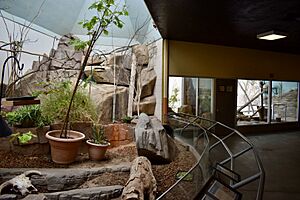
Great Apes
The Great Apes exhibit opened in 1983. It has indoor and outdoor areas for western lowland gorillas and Bornean orangutans.
Western Lowland Gorillas
The zoo has a family troop of gorillas led by a male named Husani. In 2020, a female named Jabali gave birth to a baby girl named Georgia. Another female, Pele, had a baby boy named Addo in May 2024. This growing family is part of a special breeding program to help protect gorillas.
Bornean Orangutans
Next to the gorillas live the orangutans. The zoo is home to a breeding pair, Mia and Kawan, and two orphaned siblings, Acara and Tuah. After their mother, Eve, passed away, the keepers trained Acara to be a surrogate mother to her baby brother, Tuah. This was the first time an older sibling had ever done this, and it was a great success.
Primate Forest
Opened in 1997, Primate Forest has natural-looking habitats for monkeys. It replaced the old concrete "Monkey Island." The outdoor areas are enclosed with a light mesh so visitors can see the animals clearly. The indoor habitats are climate-controlled for the winter.
Today, the exhibit is home to five species, including guerezas, spider monkeys, and black howler monkeys. The animals rotate between the different indoor and outdoor spaces.

High Desert Oasis
This area used to be the elephant exhibit. Now, it features animals from harsh environments like the Gobi Desert. Species like Przewalski’s horse, Hartmann's mountain zebra, southern white rhinoceros, and Bactrian camel rotate through the yards.
The exhibit is home to Princess, an elderly rhino who gets special care for her arthritis and allergies. It also houses bachelor (all-male) herds of Przewalski's horses and Hartmann's mountain zebras. This helps other zoos make space for breeding new babies.
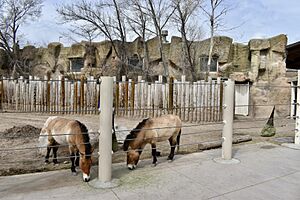
Asian Highlands
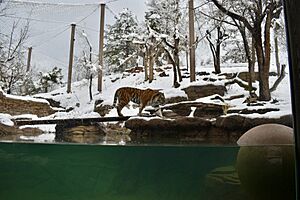
Opened in 2006, Asian Highlands looks like a village in the Himalayas. It has large, outdoor habitats for big cats from Asia, such as Amur tigers, snow leopards, and Amur leopards. A catwalk even lets the tigers walk over the heads of guests!
The zoo has had great success breeding endangered cats here. Since 2017, the Amur leopard pair has had seven cubs, which is a huge help for this rare species. In 2018, red pandas returned to the zoo in a new habitat at the entrance of Asian Highlands.
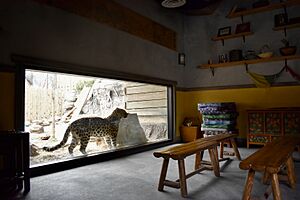
Rocky Shores
Opened in 2012, this exhibit showcases animals from the western coast of North America. It features underwater viewing areas for polar bears, California sea lions, and harbor seals. You can also see grizzly bears, North American river otters, and bald eagles.
Many animals in Rocky Shores are rescues. The three grizzly bears—Koda, Dolly, and Lou Lou—were orphaned as cubs. Maverick the sea lion was found abandoned on a beach. The two bald eagles, Marie and Nemo, were injured in Alaska and can no longer fly. Rocky Shores gives these animals a safe, permanent home.
African Savanna
This large exhibit, opened in 2014, looks like the grasslands of East Africa. It is the zoo's first mixed-species habitat, where animals like giraffes, Hartmann's mountain zebras, and ostriches live together.
Lion Hill
Lion Hill is home to the zoo's pride of African lions. The habitat has heated rocks to keep the lions warm in winter and large glass walls for up-close views. In 2016, three cubs were born here: Brutus, Titus, and Calliope.
The Grasslands
The main part of the savanna is called the Grasslands. Guests can visit Twigga Terrace to feed the giraffes. The zoo has a successful breeding herd of Hartmann's mountain zebras, which is important because the species is listed as vulnerable.
Wild Utah
Opened in May 2024, this is the zoo's newest major exhibit. It features animals native to Utah, like mountain lions, desert bighorn sheep, and a bobcat. The goal is to teach visitors about the state's amazing wildlife.
A boardwalk goes around Emigration Creek, a waterway that runs through the zoo, so guests can learn about Utah's river habitats. The exhibit also includes a new home for the zoo's Boreal Toad Conservation Center, which works to save a declining species of toad.
Zoofari Express
The zoo's train, the Zoofari Express, has a new track that goes around the Wild Utah exhibit. From the train, guests can see many of the new animals as well as those in the African Savanna.
Notable Animals
- Princess Alice: An Asian elephant who was one of the zoo's first stars in the early 1900s. Schoolchildren helped raise money to buy her from a circus.
- Shasta: The first liger (a cross between a lion and a tiger) born in America, in 1948. She was very popular and helped the zoo attract many visitors. She lived to be 24, a world record for a liger.
- Gorgeous: A female gorilla who was famous for interacting with guests. She was one of the first gorillas to have cataract surgery.
- Dari: An African elephant who lived to be 55, making her one of the oldest in the world.
- Daphne: A giraffe who lived to be 31, double the average lifespan for her species. She had nine babies at the zoo.
Conservation Efforts
Hogle Zoo is dedicated to protecting wildlife. The Big Six Program supports organizations working to save six endangered species: the African lion, Bornean orangutan, polar bear, African elephant, radiated tortoise, and boreal toad.
The zoo has also helped reintroduce animals back into the wild. These include bald eagles, golden lion tamarins, and black-and-white ruffed lemurs. By breeding these animals and releasing them, the zoo helps increase their numbers in their natural habitats.
Images for kids
See also
 In Spanish: Zoológico de Hogle para niños
In Spanish: Zoológico de Hogle para niños


